University Assignment: GEOG 2221 - Core and Periphery Areas in Canada
VerifiedAdded on 2022/10/31
|9
|1729
|496
Report
AI Summary
This report provides an analysis of the core and periphery areas in Canada, drawing on Stadel's (2009) framework. It defines core areas as regions with equitable resource distribution, economic and political power, and favorable geographic features, contrasting them with peripheral regions characterized by uneven resource distribution and infrastructural limitations. The report examines the transition of peripheral regions to core areas, such as the Saskatchewan CMAs, and identifies key factors like resource discovery and population growth. It also outlines obstacles to this transition, including territorial size and political challenges. Furthermore, the report discusses Bone's identification of four fault lines—centralist/decentralist, English/French-speaking, Indigenous/non-Indigenous, and old/new Canadians—and their impact on regional cohesiveness. Finally, it identifies and characterizes six geographical regions of Canada. The report concludes by emphasizing the factors that contribute to regional development and the influence of fault lines on Canada's regional cohesiveness.
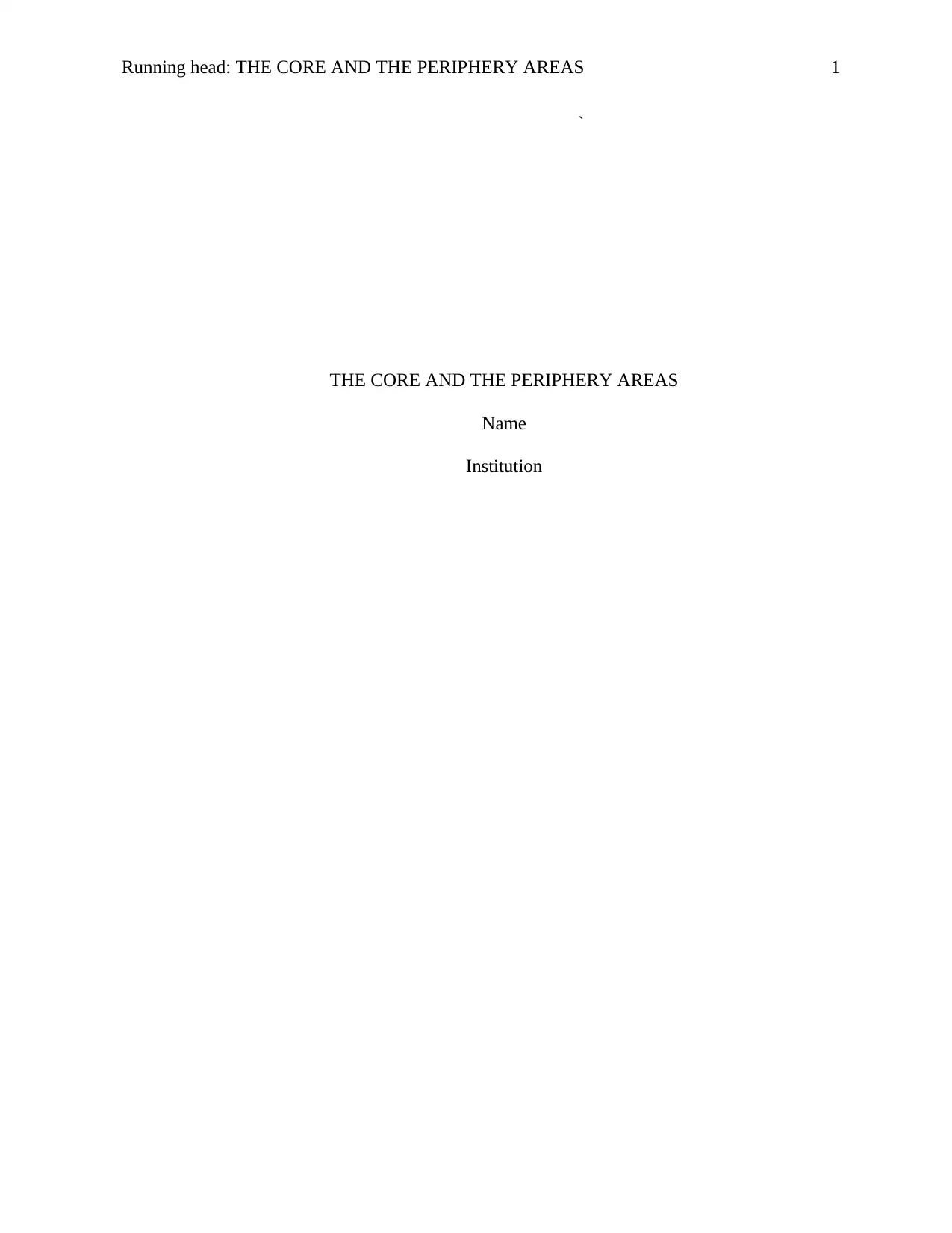
Running head: THE CORE AND THE PERIPHERY AREAS 1
`
THE CORE AND THE PERIPHERY AREAS
Name
Institution
`
THE CORE AND THE PERIPHERY AREAS
Name
Institution
Paraphrase This Document
Need a fresh take? Get an instant paraphrase of this document with our AI Paraphraser
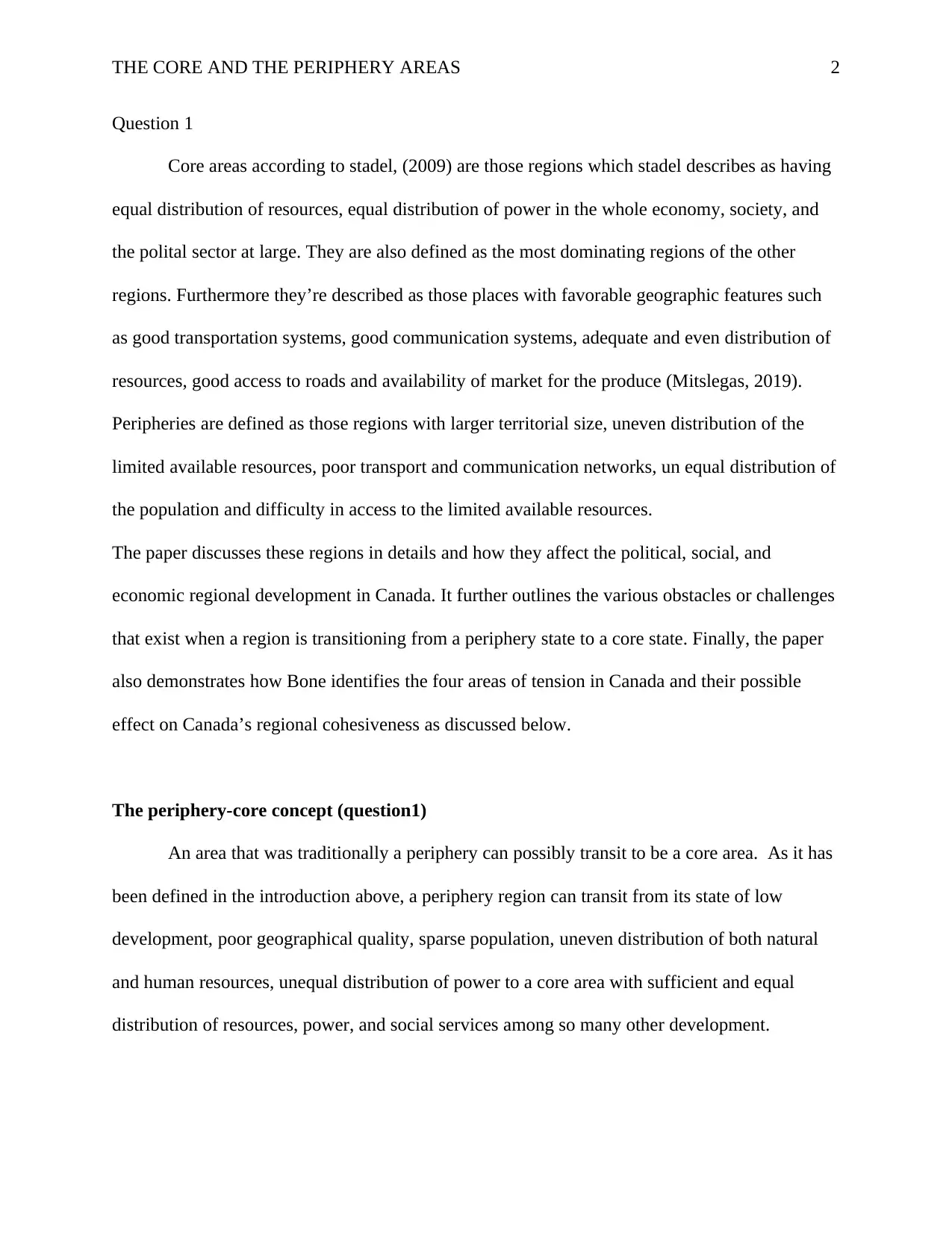
THE CORE AND THE PERIPHERY AREAS 2
Question 1
Core areas according to stadel, (2009) are those regions which stadel describes as having
equal distribution of resources, equal distribution of power in the whole economy, society, and
the polital sector at large. They are also defined as the most dominating regions of the other
regions. Furthermore they’re described as those places with favorable geographic features such
as good transportation systems, good communication systems, adequate and even distribution of
resources, good access to roads and availability of market for the produce (Mitslegas, 2019).
Peripheries are defined as those regions with larger territorial size, uneven distribution of the
limited available resources, poor transport and communication networks, un equal distribution of
the population and difficulty in access to the limited available resources.
The paper discusses these regions in details and how they affect the political, social, and
economic regional development in Canada. It further outlines the various obstacles or challenges
that exist when a region is transitioning from a periphery state to a core state. Finally, the paper
also demonstrates how Bone identifies the four areas of tension in Canada and their possible
effect on Canada’s regional cohesiveness as discussed below.
The periphery-core concept (question1)
An area that was traditionally a periphery can possibly transit to be a core area. As it has
been defined in the introduction above, a periphery region can transit from its state of low
development, poor geographical quality, sparse population, uneven distribution of both natural
and human resources, unequal distribution of power to a core area with sufficient and equal
distribution of resources, power, and social services among so many other development.
Question 1
Core areas according to stadel, (2009) are those regions which stadel describes as having
equal distribution of resources, equal distribution of power in the whole economy, society, and
the polital sector at large. They are also defined as the most dominating regions of the other
regions. Furthermore they’re described as those places with favorable geographic features such
as good transportation systems, good communication systems, adequate and even distribution of
resources, good access to roads and availability of market for the produce (Mitslegas, 2019).
Peripheries are defined as those regions with larger territorial size, uneven distribution of the
limited available resources, poor transport and communication networks, un equal distribution of
the population and difficulty in access to the limited available resources.
The paper discusses these regions in details and how they affect the political, social, and
economic regional development in Canada. It further outlines the various obstacles or challenges
that exist when a region is transitioning from a periphery state to a core state. Finally, the paper
also demonstrates how Bone identifies the four areas of tension in Canada and their possible
effect on Canada’s regional cohesiveness as discussed below.
The periphery-core concept (question1)
An area that was traditionally a periphery can possibly transit to be a core area. As it has
been defined in the introduction above, a periphery region can transit from its state of low
development, poor geographical quality, sparse population, uneven distribution of both natural
and human resources, unequal distribution of power to a core area with sufficient and equal
distribution of resources, power, and social services among so many other development.
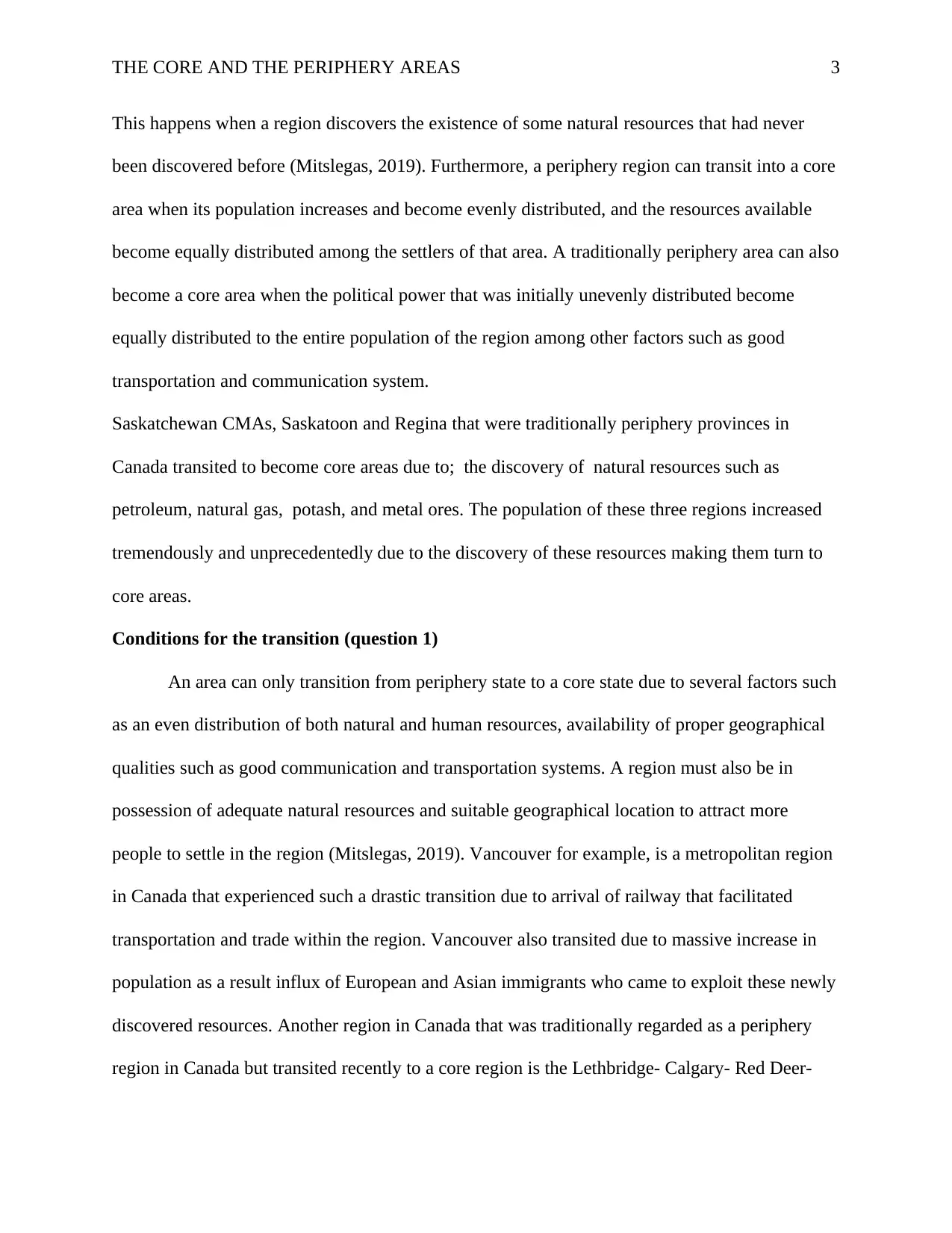
THE CORE AND THE PERIPHERY AREAS 3
This happens when a region discovers the existence of some natural resources that had never
been discovered before (Mitslegas, 2019). Furthermore, a periphery region can transit into a core
area when its population increases and become evenly distributed, and the resources available
become equally distributed among the settlers of that area. A traditionally periphery area can also
become a core area when the political power that was initially unevenly distributed become
equally distributed to the entire population of the region among other factors such as good
transportation and communication system.
Saskatchewan CMAs, Saskatoon and Regina that were traditionally periphery provinces in
Canada transited to become core areas due to; the discovery of natural resources such as
petroleum, natural gas, potash, and metal ores. The population of these three regions increased
tremendously and unprecedentedly due to the discovery of these resources making them turn to
core areas.
Conditions for the transition (question 1)
An area can only transition from periphery state to a core state due to several factors such
as an even distribution of both natural and human resources, availability of proper geographical
qualities such as good communication and transportation systems. A region must also be in
possession of adequate natural resources and suitable geographical location to attract more
people to settle in the region (Mitslegas, 2019). Vancouver for example, is a metropolitan region
in Canada that experienced such a drastic transition due to arrival of railway that facilitated
transportation and trade within the region. Vancouver also transited due to massive increase in
population as a result influx of European and Asian immigrants who came to exploit these newly
discovered resources. Another region in Canada that was traditionally regarded as a periphery
region in Canada but transited recently to a core region is the Lethbridge- Calgary- Red Deer-
This happens when a region discovers the existence of some natural resources that had never
been discovered before (Mitslegas, 2019). Furthermore, a periphery region can transit into a core
area when its population increases and become evenly distributed, and the resources available
become equally distributed among the settlers of that area. A traditionally periphery area can also
become a core area when the political power that was initially unevenly distributed become
equally distributed to the entire population of the region among other factors such as good
transportation and communication system.
Saskatchewan CMAs, Saskatoon and Regina that were traditionally periphery provinces in
Canada transited to become core areas due to; the discovery of natural resources such as
petroleum, natural gas, potash, and metal ores. The population of these three regions increased
tremendously and unprecedentedly due to the discovery of these resources making them turn to
core areas.
Conditions for the transition (question 1)
An area can only transition from periphery state to a core state due to several factors such
as an even distribution of both natural and human resources, availability of proper geographical
qualities such as good communication and transportation systems. A region must also be in
possession of adequate natural resources and suitable geographical location to attract more
people to settle in the region (Mitslegas, 2019). Vancouver for example, is a metropolitan region
in Canada that experienced such a drastic transition due to arrival of railway that facilitated
transportation and trade within the region. Vancouver also transited due to massive increase in
population as a result influx of European and Asian immigrants who came to exploit these newly
discovered resources. Another region in Canada that was traditionally regarded as a periphery
region in Canada but transited recently to a core region is the Lethbridge- Calgary- Red Deer-
⊘ This is a preview!⊘
Do you want full access?
Subscribe today to unlock all pages.

Trusted by 1+ million students worldwide
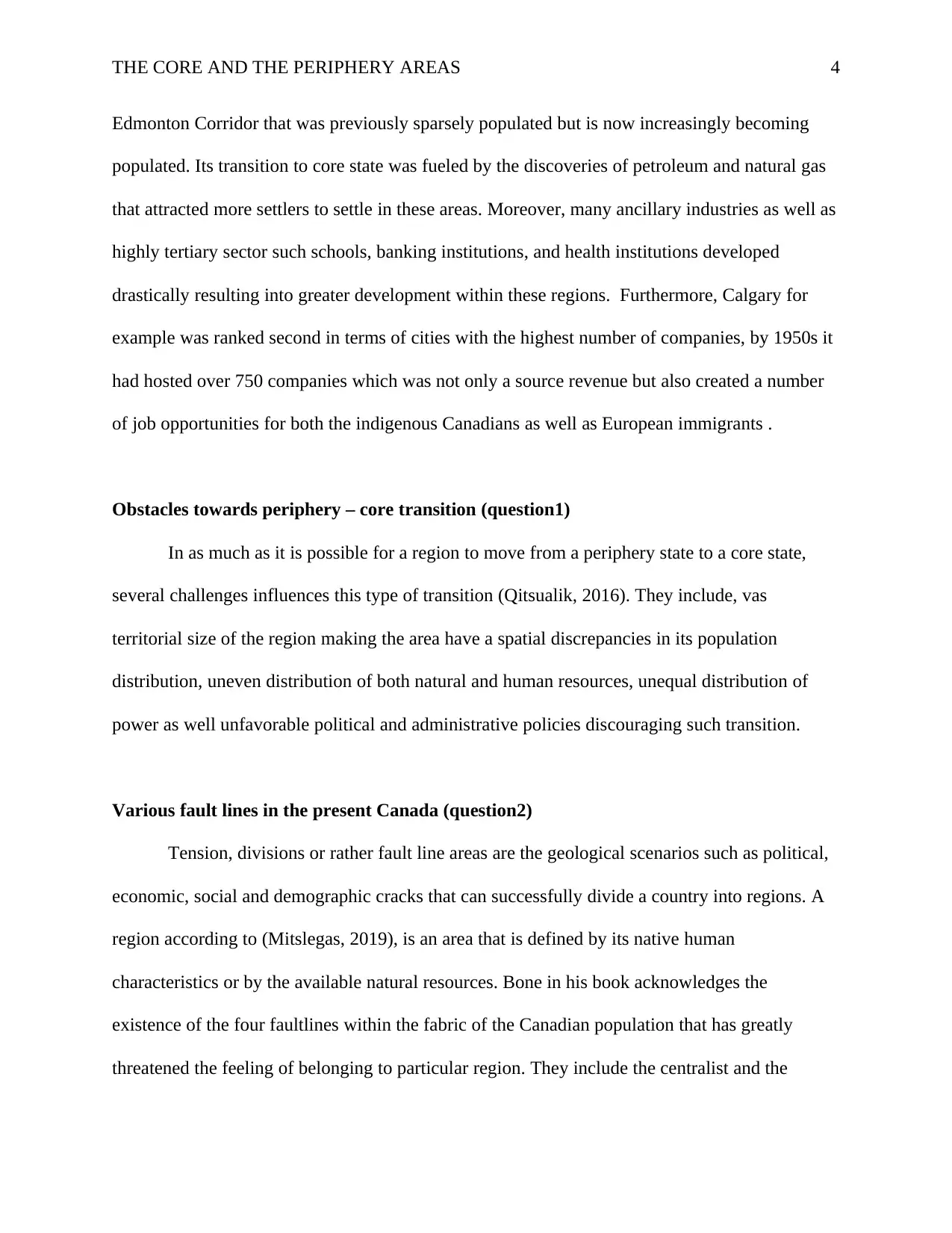
THE CORE AND THE PERIPHERY AREAS 4
Edmonton Corridor that was previously sparsely populated but is now increasingly becoming
populated. Its transition to core state was fueled by the discoveries of petroleum and natural gas
that attracted more settlers to settle in these areas. Moreover, many ancillary industries as well as
highly tertiary sector such schools, banking institutions, and health institutions developed
drastically resulting into greater development within these regions. Furthermore, Calgary for
example was ranked second in terms of cities with the highest number of companies, by 1950s it
had hosted over 750 companies which was not only a source revenue but also created a number
of job opportunities for both the indigenous Canadians as well as European immigrants .
Obstacles towards periphery – core transition (question1)
In as much as it is possible for a region to move from a periphery state to a core state,
several challenges influences this type of transition (Qitsualik, 2016). They include, vas
territorial size of the region making the area have a spatial discrepancies in its population
distribution, uneven distribution of both natural and human resources, unequal distribution of
power as well unfavorable political and administrative policies discouraging such transition.
Various fault lines in the present Canada (question2)
Tension, divisions or rather fault line areas are the geological scenarios such as political,
economic, social and demographic cracks that can successfully divide a country into regions. A
region according to (Mitslegas, 2019), is an area that is defined by its native human
characteristics or by the available natural resources. Bone in his book acknowledges the
existence of the four faultlines within the fabric of the Canadian population that has greatly
threatened the feeling of belonging to particular region. They include the centralist and the
Edmonton Corridor that was previously sparsely populated but is now increasingly becoming
populated. Its transition to core state was fueled by the discoveries of petroleum and natural gas
that attracted more settlers to settle in these areas. Moreover, many ancillary industries as well as
highly tertiary sector such schools, banking institutions, and health institutions developed
drastically resulting into greater development within these regions. Furthermore, Calgary for
example was ranked second in terms of cities with the highest number of companies, by 1950s it
had hosted over 750 companies which was not only a source revenue but also created a number
of job opportunities for both the indigenous Canadians as well as European immigrants .
Obstacles towards periphery – core transition (question1)
In as much as it is possible for a region to move from a periphery state to a core state,
several challenges influences this type of transition (Qitsualik, 2016). They include, vas
territorial size of the region making the area have a spatial discrepancies in its population
distribution, uneven distribution of both natural and human resources, unequal distribution of
power as well unfavorable political and administrative policies discouraging such transition.
Various fault lines in the present Canada (question2)
Tension, divisions or rather fault line areas are the geological scenarios such as political,
economic, social and demographic cracks that can successfully divide a country into regions. A
region according to (Mitslegas, 2019), is an area that is defined by its native human
characteristics or by the available natural resources. Bone in his book acknowledges the
existence of the four faultlines within the fabric of the Canadian population that has greatly
threatened the feeling of belonging to particular region. They include the centralist and the
Paraphrase This Document
Need a fresh take? Get an instant paraphrase of this document with our AI Paraphraser
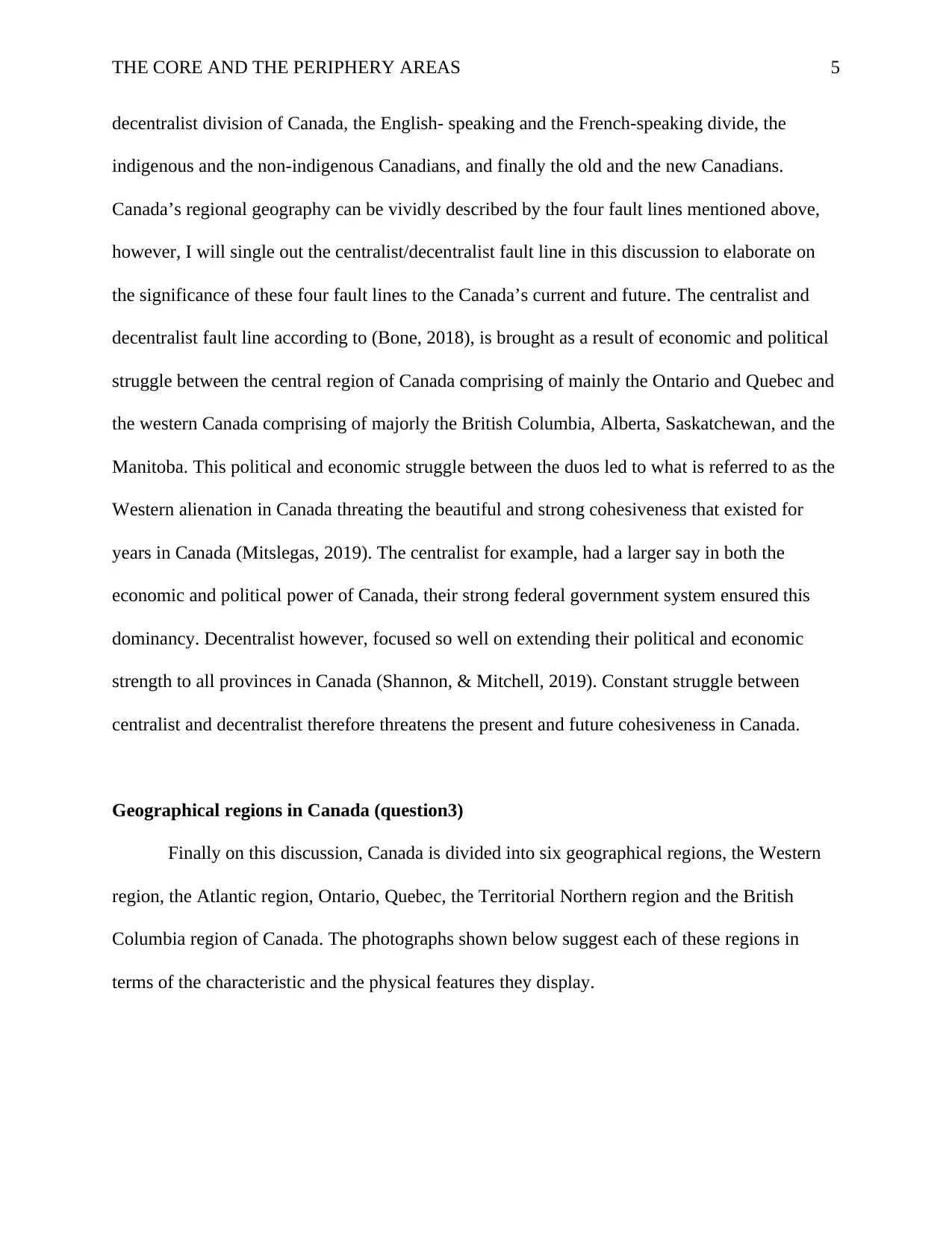
THE CORE AND THE PERIPHERY AREAS 5
decentralist division of Canada, the English- speaking and the French-speaking divide, the
indigenous and the non-indigenous Canadians, and finally the old and the new Canadians.
Canada’s regional geography can be vividly described by the four fault lines mentioned above,
however, I will single out the centralist/decentralist fault line in this discussion to elaborate on
the significance of these four fault lines to the Canada’s current and future. The centralist and
decentralist fault line according to (Bone, 2018), is brought as a result of economic and political
struggle between the central region of Canada comprising of mainly the Ontario and Quebec and
the western Canada comprising of majorly the British Columbia, Alberta, Saskatchewan, and the
Manitoba. This political and economic struggle between the duos led to what is referred to as the
Western alienation in Canada threating the beautiful and strong cohesiveness that existed for
years in Canada (Mitslegas, 2019). The centralist for example, had a larger say in both the
economic and political power of Canada, their strong federal government system ensured this
dominancy. Decentralist however, focused so well on extending their political and economic
strength to all provinces in Canada (Shannon, & Mitchell, 2019). Constant struggle between
centralist and decentralist therefore threatens the present and future cohesiveness in Canada.
Geographical regions in Canada (question3)
Finally on this discussion, Canada is divided into six geographical regions, the Western
region, the Atlantic region, Ontario, Quebec, the Territorial Northern region and the British
Columbia region of Canada. The photographs shown below suggest each of these regions in
terms of the characteristic and the physical features they display.
decentralist division of Canada, the English- speaking and the French-speaking divide, the
indigenous and the non-indigenous Canadians, and finally the old and the new Canadians.
Canada’s regional geography can be vividly described by the four fault lines mentioned above,
however, I will single out the centralist/decentralist fault line in this discussion to elaborate on
the significance of these four fault lines to the Canada’s current and future. The centralist and
decentralist fault line according to (Bone, 2018), is brought as a result of economic and political
struggle between the central region of Canada comprising of mainly the Ontario and Quebec and
the western Canada comprising of majorly the British Columbia, Alberta, Saskatchewan, and the
Manitoba. This political and economic struggle between the duos led to what is referred to as the
Western alienation in Canada threating the beautiful and strong cohesiveness that existed for
years in Canada (Mitslegas, 2019). The centralist for example, had a larger say in both the
economic and political power of Canada, their strong federal government system ensured this
dominancy. Decentralist however, focused so well on extending their political and economic
strength to all provinces in Canada (Shannon, & Mitchell, 2019). Constant struggle between
centralist and decentralist therefore threatens the present and future cohesiveness in Canada.
Geographical regions in Canada (question3)
Finally on this discussion, Canada is divided into six geographical regions, the Western
region, the Atlantic region, Ontario, Quebec, the Territorial Northern region and the British
Columbia region of Canada. The photographs shown below suggest each of these regions in
terms of the characteristic and the physical features they display.
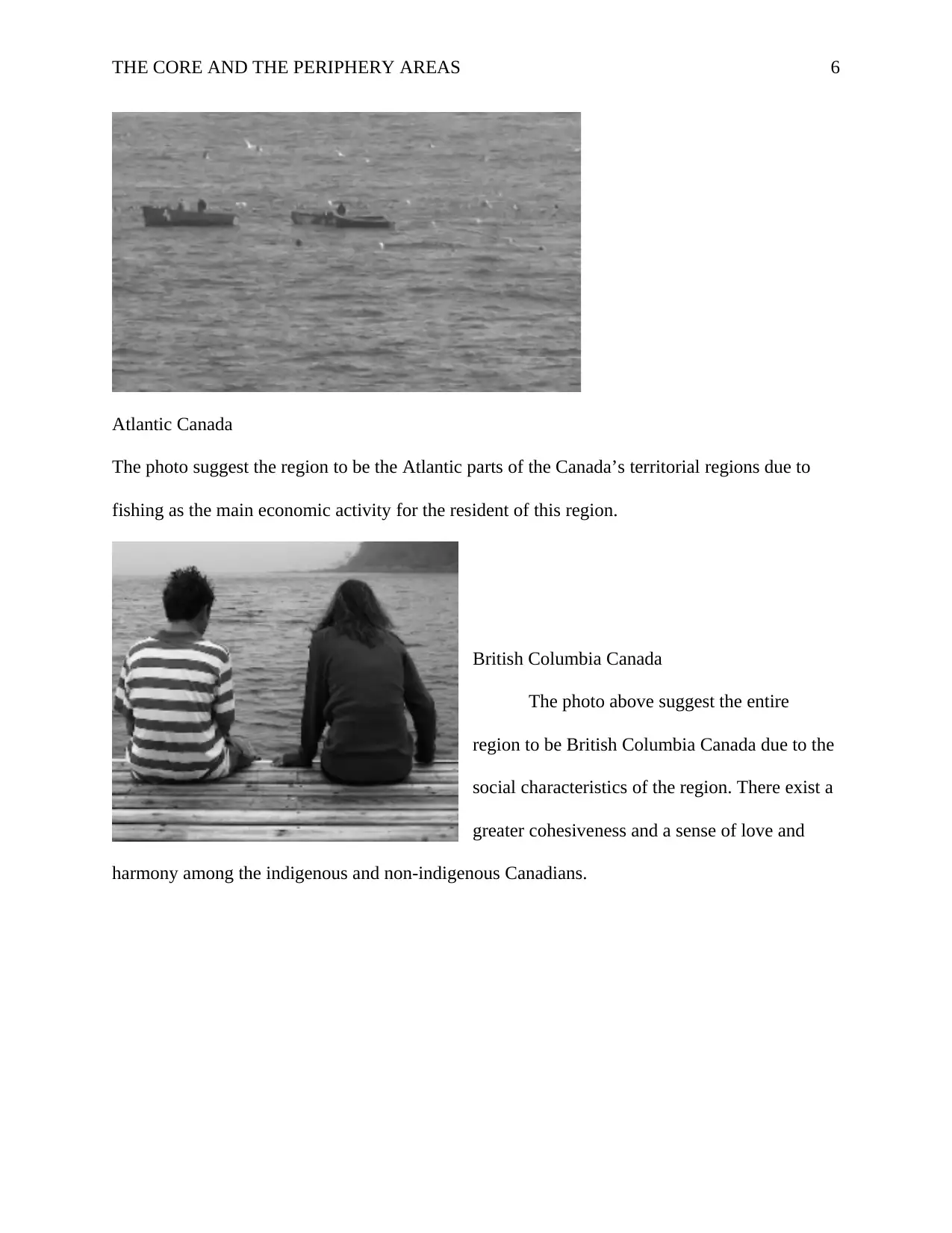
THE CORE AND THE PERIPHERY AREAS 6
Atlantic Canada
The photo suggest the region to be the Atlantic parts of the Canada’s territorial regions due to
fishing as the main economic activity for the resident of this region.
British Columbia Canada
The photo above suggest the entire
region to be British Columbia Canada due to the
social characteristics of the region. There exist a
greater cohesiveness and a sense of love and
harmony among the indigenous and non-indigenous Canadians.
Atlantic Canada
The photo suggest the region to be the Atlantic parts of the Canada’s territorial regions due to
fishing as the main economic activity for the resident of this region.
British Columbia Canada
The photo above suggest the entire
region to be British Columbia Canada due to the
social characteristics of the region. There exist a
greater cohesiveness and a sense of love and
harmony among the indigenous and non-indigenous Canadians.
⊘ This is a preview!⊘
Do you want full access?
Subscribe today to unlock all pages.

Trusted by 1+ million students worldwide
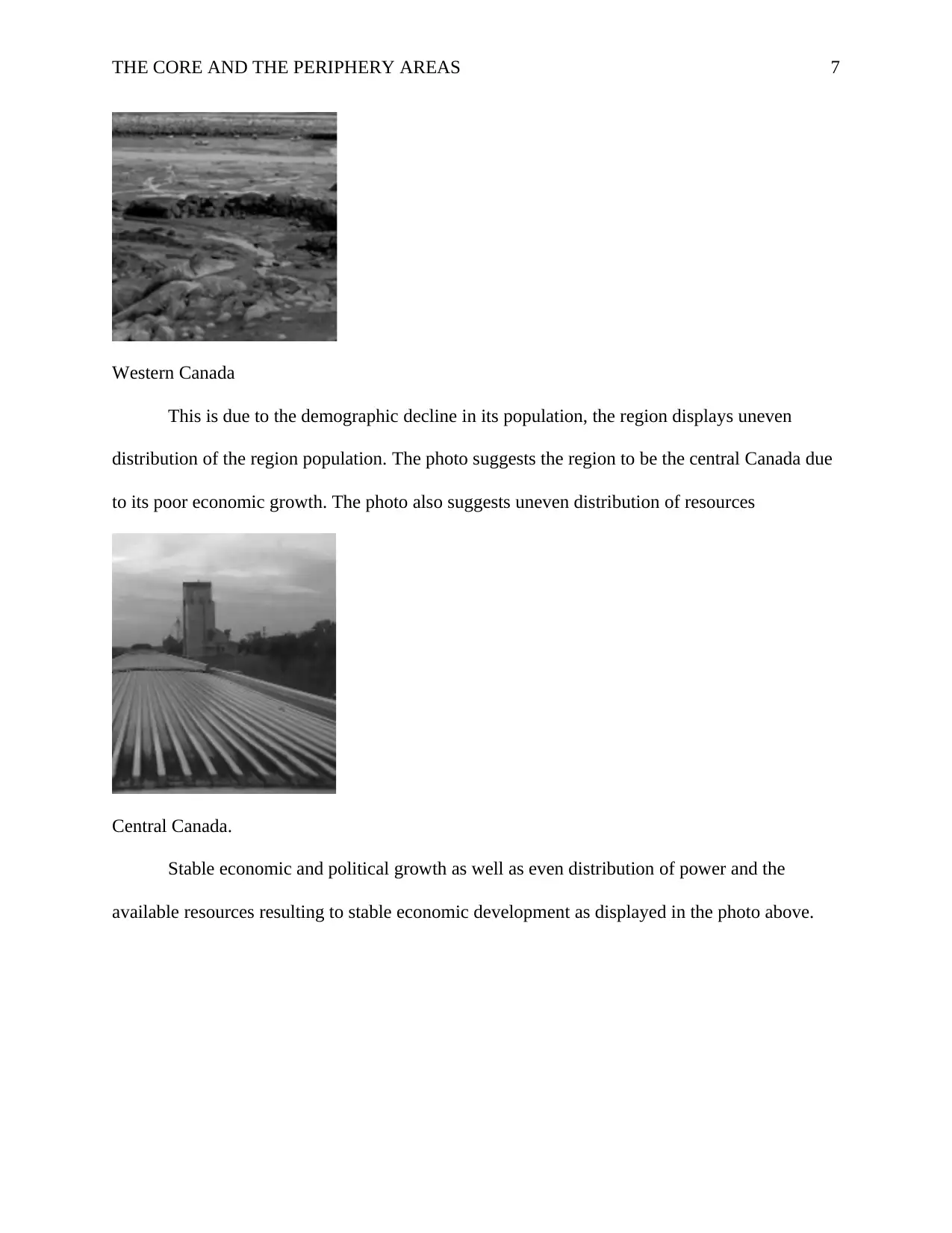
THE CORE AND THE PERIPHERY AREAS 7
Western Canada
This is due to the demographic decline in its population, the region displays uneven
distribution of the region population. The photo suggests the region to be the central Canada due
to its poor economic growth. The photo also suggests uneven distribution of resources
Central Canada.
Stable economic and political growth as well as even distribution of power and the
available resources resulting to stable economic development as displayed in the photo above.
Western Canada
This is due to the demographic decline in its population, the region displays uneven
distribution of the region population. The photo suggests the region to be the central Canada due
to its poor economic growth. The photo also suggests uneven distribution of resources
Central Canada.
Stable economic and political growth as well as even distribution of power and the
available resources resulting to stable economic development as displayed in the photo above.
Paraphrase This Document
Need a fresh take? Get an instant paraphrase of this document with our AI Paraphraser
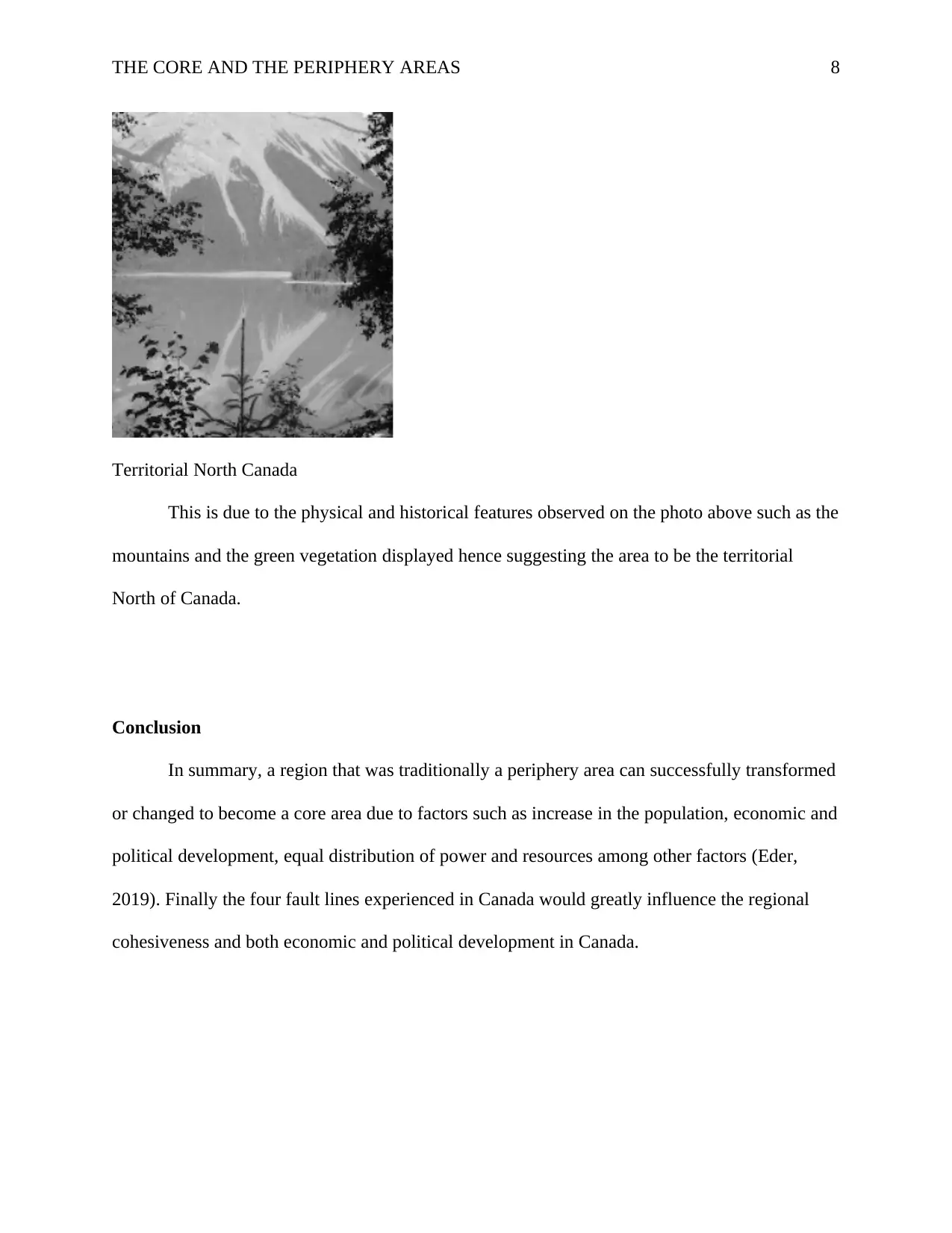
THE CORE AND THE PERIPHERY AREAS 8
Territorial North Canada
This is due to the physical and historical features observed on the photo above such as the
mountains and the green vegetation displayed hence suggesting the area to be the territorial
North of Canada.
Conclusion
In summary, a region that was traditionally a periphery area can successfully transformed
or changed to become a core area due to factors such as increase in the population, economic and
political development, equal distribution of power and resources among other factors (Eder,
2019). Finally the four fault lines experienced in Canada would greatly influence the regional
cohesiveness and both economic and political development in Canada.
Territorial North Canada
This is due to the physical and historical features observed on the photo above such as the
mountains and the green vegetation displayed hence suggesting the area to be the territorial
North of Canada.
Conclusion
In summary, a region that was traditionally a periphery area can successfully transformed
or changed to become a core area due to factors such as increase in the population, economic and
political development, equal distribution of power and resources among other factors (Eder,
2019). Finally the four fault lines experienced in Canada would greatly influence the regional
cohesiveness and both economic and political development in Canada.
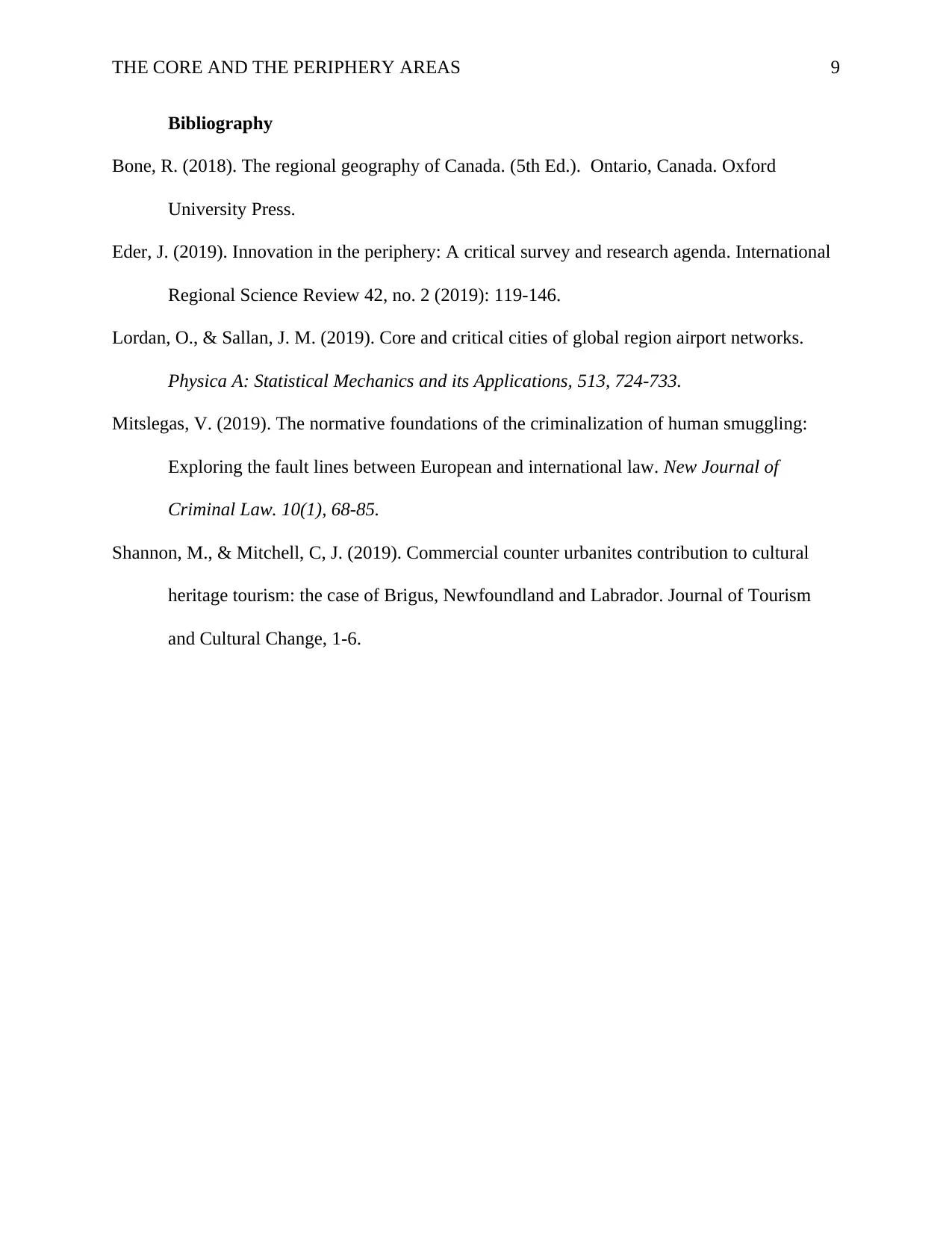
THE CORE AND THE PERIPHERY AREAS 9
Bibliography
Bone, R. (2018). The regional geography of Canada. (5th Ed.). Ontario, Canada. Oxford
University Press.
Eder, J. (2019). Innovation in the periphery: A critical survey and research agenda. International
Regional Science Review 42, no. 2 (2019): 119-146.
Lordan, O., & Sallan, J. M. (2019). Core and critical cities of global region airport networks.
Physica A: Statistical Mechanics and its Applications, 513, 724-733.
Mitslegas, V. (2019). The normative foundations of the criminalization of human smuggling:
Exploring the fault lines between European and international law. New Journal of
Criminal Law. 10(1), 68-85.
Shannon, M., & Mitchell, C, J. (2019). Commercial counter urbanites contribution to cultural
heritage tourism: the case of Brigus, Newfoundland and Labrador. Journal of Tourism
and Cultural Change, 1-6.
Bibliography
Bone, R. (2018). The regional geography of Canada. (5th Ed.). Ontario, Canada. Oxford
University Press.
Eder, J. (2019). Innovation in the periphery: A critical survey and research agenda. International
Regional Science Review 42, no. 2 (2019): 119-146.
Lordan, O., & Sallan, J. M. (2019). Core and critical cities of global region airport networks.
Physica A: Statistical Mechanics and its Applications, 513, 724-733.
Mitslegas, V. (2019). The normative foundations of the criminalization of human smuggling:
Exploring the fault lines between European and international law. New Journal of
Criminal Law. 10(1), 68-85.
Shannon, M., & Mitchell, C, J. (2019). Commercial counter urbanites contribution to cultural
heritage tourism: the case of Brigus, Newfoundland and Labrador. Journal of Tourism
and Cultural Change, 1-6.
⊘ This is a preview!⊘
Do you want full access?
Subscribe today to unlock all pages.

Trusted by 1+ million students worldwide
1 out of 9
Related Documents
Your All-in-One AI-Powered Toolkit for Academic Success.
+13062052269
info@desklib.com
Available 24*7 on WhatsApp / Email
![[object Object]](/_next/static/media/star-bottom.7253800d.svg)
Unlock your academic potential
Copyright © 2020–2025 A2Z Services. All Rights Reserved. Developed and managed by ZUCOL.





